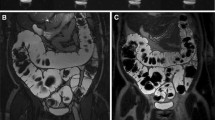Abstract
Background
Magnetic resonance colonography (MRC) with fecal tagging has recently been investigated in clinical studies for the detection of polyps. We assessed fecal tagging MRC in a field trial.
Methods
Forty-two patients in a private gastroenterologic practice underwent MRC with barium-based fecal tagging (150 mL of 100% barium at each of 6 main meals before MRC) and conventional colonoscopy. Diagnostic accuracy of MRC and patient acceptance were assessed and compared with the respective results of conventional colonoscopy.
Results
Eighteen percent of all MRC examinations showed a remaining high stool signal in the colon that impeded a reliable inclusion or exclusion of polyps. On a lesion-by-lesion basis, sensitivities for polyp detection were 100% for polyps larger than 2 cm (n = 1), 40% for polyps between 10 and 19 mm, 16.7% for polyps between 6 and 9 mm, and 9.1% for polyps smaller than 6 mm. The main reason for the low acceptance of MRC was the barium preparation, which was rated worse than the bowel cleaning procedure with conventional colonoscopy.
Conclusion
MRC with fecal tagging must be further optimized. The large amount of barium resulted in poor patient acceptance, and barium according to this protocol did not provide sufficient stool darkening. Other strategies, such as increasing the hydration of stool, must be developed.







Similar content being viewed by others
References
H Neuhaus (1999) ArticleTitleScreening for colorectal cancer in Germany: guidelines, reality Endoscopy 31 468–470 Occurrence Handle10.1055/s-1999-37 Occurrence Handle10494688
SH Landis T Murray S Bodden PA Wingo (1998) ArticleTitleCancer statistics, 1998 CA Cancer J Clin 48 6–29 Occurrence Handle9449931
MJ O’Brien SJ Winawer AG Zauber et al. (1990) ArticleTitleThe National Polyp Study. Patient and polyp characteristics associated with high-grade dysplasia in colorectal adenomas Gastroenterology 98 371–379 Occurrence Handle2403953
DA Liebermann FW Smith (1991) ArticleTitleScreening for colon malignancy with colonoscopy Am J Gastroenterol 86 946–951 Occurrence Handle1858758
DA Lieberman (1995) ArticleTitleCost-effectiveness model for colon cancer screening Gastroenterology 109 989–995 Occurrence Handle10.1016/0016-5085(95)90744-0
N Petrelli AM Michalek A Freedman et al. (1994) ArticleTitleImmunochemical versus occult blood stool tests: results of a community based screening program Surg Oncol 3 27–36 Occurrence Handle10.1016/0960-7404(94)90021-3 Occurrence Handle8186868
Y Niv AD Sperber (1995) ArticleTitleSensitivity, specificity, and predictive value of fecal occult blood testing (Hemoccult II) for colorectal neoplasia in symptomatic patients: a prospective study with total colonoscopy Am J Gastroenterol 90 1974–1977 Occurrence Handle7485003
JM Reilly GH Ballantyne FX Fleming et al. (1990) ArticleTitleEvaluation of the occult blood test in screening for colorectal neoplasms. A prospective study using flexible endoscopy Am Surg 56 119–123 Occurrence Handle2316930
DA Ahlquist AP Shuber (2002) ArticleTitleStool screening for colorectal cancer: evolution from occult blood to molecular markers Clin Chim Acta 315 157–168 Occurrence Handle10.1016/S0009-8981(01)00712-4 Occurrence Handle11728417
DJ Ott YM Chen DW Gelfand et al. (1986) ArticleTitleSingle contrast vs double contrast barium enema in the detection of colonic polyps AJR 146 993–996 Occurrence Handle3485914
RF Thoeni A Petras (1982) ArticleTitleDouble-contrast barium-enema examination and endoscopy in the detection of polypoid lesions in the cecum and ascending colon Radiology 144 257–260 Occurrence Handle7089277
HM Fenlon DP Nunes PC Schroy et al. (1999) ArticleTitleA comparison of virtual and conventional colonoscopy for the detection of colorectal polyps N Engl J Med 341 1496–1503 Occurrence Handle10.1056/NEJM199911113412003 Occurrence Handle10559450
G Pappalardo E Polettini FM Frattaroli et al. (2000) ArticleTitleMagnetic resonance colonography versus conventional colonoscopy for the detection of colonic endoluminal lesions Gastroenterology 119 300–304 Occurrence Handle10.1053/gast.2000.9353 Occurrence Handle10930364
W Luboldt P Bauerfeind S Wildermuth et al. (2000) ArticleTitleColonic masses: detection with MR colonography Radiology 216 383– 388 Occurrence Handle10924558
B Saar JT Heverhagen T Obst et al. (2000) ArticleTitleMagnetic resonance colonography and virtual magnetic resonance colonoscopy with the 1.0-T system: a feasibility study Invest Radiol 35 521–526 Occurrence Handle10.1097/00004424-200009000-00001 Occurrence Handle10981995
RT Villavicencio DX Rex (2000) ArticleTitleColonic adenomas: prevalence and incidence rates, growth rates, and miss rates at colonoscopy Semin Gastrointest Dis 11 185–193 Occurrence Handle11057946
JF Debatin W Luboldt P Bauerfeind (1999) ArticleTitleVirtual colonoscopy in 1999: computed tomography or magnetic resonance imaging? Endoscopy 3 174–179 Occurrence Handle10.1055/s-1999-13668
MJ Elwood G Ali MT Schlup et al. (1995) ArticleTitleFlexible sigmoidoscopy or colonoscopy for colorectal screening: a randomized trial of performance and acceptability Cancer Detect Prev 19 337–347 Occurrence Handle7553676
TC Lauenstein G Holtmann D Schoenfelder et al. (2001) ArticleTitleMR colonography without bowel cleansing: a new strategy to improve patient acceptance AJR 177 823–827 Occurrence Handle11566681
TC Lauenstein SC Goehde SG Ruehm et al. (2002) ArticleTitleMR-colonography with barium-based fecal tagging: initial clinical experience Radiology 223 248–254 Occurrence Handle11930074
SC Goehde W Ajaj T Lauenstein et al. (2004) ArticleTitleImpact of diet on stool signal in dark lumen MR colonography J Magn Reson Imaging 20 272–278 Occurrence Handle10.1002/jmri.20098 Occurrence Handle15269953
Author information
Authors and Affiliations
Corresponding author
Rights and permissions
About this article
Cite this article
Goehde, S.C., Descher, E., Boekstegers, A. et al. Dark lumen MR colonography based on fecal tagging for detection of colorectal masses: accuracy and patient acceptance. Abdom Imaging 30, 576–583 (2005). https://doi.org/10.1007/s00261-004-0290-4
Received:
Accepted:
Published:
Issue Date:
DOI: https://doi.org/10.1007/s00261-004-0290-4




